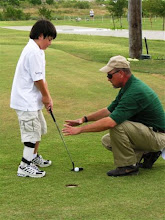This cracks me up. In the video these guys don't know the difference between face angle and center of gravity. Yet in the text, center of gravity is printed and center of gravity is not correct. These guys want people to buy this driver and then figure out how to make the adjustments to make better shots? (If you really have to experiment with this contraption, don't pay $500 to do it. Wait a few months and you can probably buy one, nearly new, hardly ever used, off of the trade in rack at your local big box retailer for about $100.)
The proliferation of bad information is alive and well and as long as folks are willing to buy this stuff. Who really cares what the center of gravity and face angle are all about. It is just the business of selling equipment for the purpose of making sales. And it is from this type of sales propaganda that the golfing public receives its equipment education. Shoot, anybody can be a professional club fitter! And a high handicapper at the same time! Just read the article and watch the video. It's all perfectly clear.
Click here for full story and video: BBC News
Even if you did know what you were doing, these adjustable drivers fall short of being able to offer the full benefits of custom fitting for the maximum amount of game improvement (there are 12 basic driver fitting specifications).







